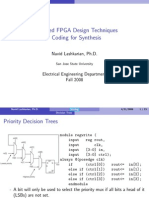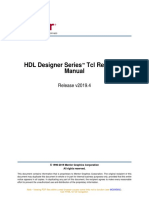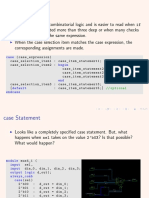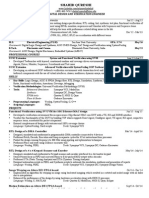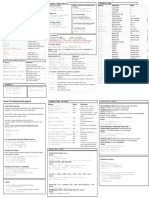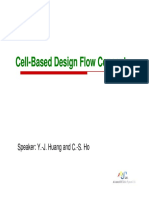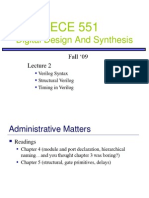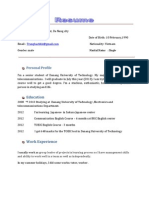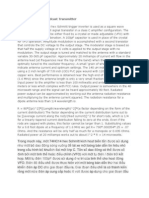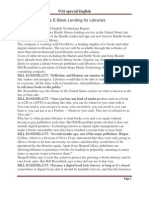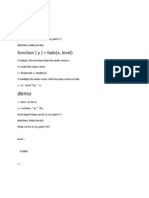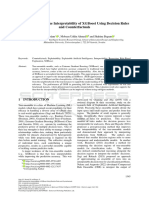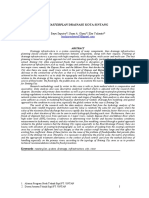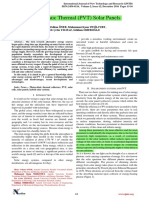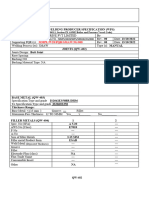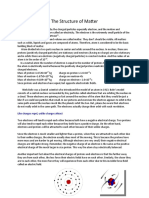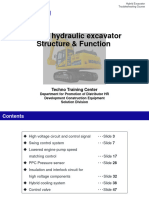Synthesizable Coding of Verilog
REF: Verilog Training Manual, CIC, July, 2008 Reuse Methodology Manual For System-ON-A-Chip Design, Third Edition 2002 Logic Synthesis with Design Complier, CIC , July, 2008
Speaker: Y. X. Chen
Advanced Reliable Systems (ARES) Lab.
Nov. 2012
1
�11/21
: Synthesizable Verilog & Coding
Synthesizable coding style in Verilog Syntax check with nLint
LAB1-simple 8-bit microprocessorVerilog code
:RTL codingnLintcode :RTL netlistsimulation
Advanced Reliable Systems (ARES) Lab.
�Outline
Basic of Logic Synthesis Concept Basic Concept of Verilog HDL Synthesizable Verilog LAB 1-1: Design Rule Check with nLint Tips for Verilog Design LAB 1-2: RTL Simulation
Advanced Reliable Systems (ARES) Lab.
�Basic Concept of the Synthesis
Advanced Reliable Systems (ARES) Lab.
�Cell-Based Design Flow
Spec. System Level
MATLAB/ C/ C++/ System C/ ADS/ Covergen (MaxSim) Memory Generator
RTL Level
Verilog/ VHDL
NC-Verilog/ ModelSim Debussy (Verdi)/ VCS Physical Compiler/ Magma Blast Fusion Design/ Power Compiler DFT Compiler/ TetraMAX NC-Verilog/ ModelSim Debussy (Verdi)/ VCS SOC Encounter/ Astro GDS II DRC/ LVS (Calibre)
PVS: Calibre xRC/ NanoSim (Time/ Power Mill)
Syntest
Logic Synthesis Design for Test Gate Level
Conformal/ Formality
Layout Level Post-Layout Verification
Tape Out
Advanced Reliable Systems (ARES) Lab. 5
�What is Synthesis
Synthesis = translation + optimization + mapping
if(high_bits == 2b10)begin residue = state_table[i]; end else begin residue = 16h0000; end
Translate (HDL Compiler)
HDL Source (RTL)
No Timing Info. Optimize + Mapping (HDL Compiler)
Generic Boolean (GTECT)
Timing Info. The synthesis is constraint driven and technology independent !!
Advanced Reliable Systems (ARES) Lab.
Target Technology
6
�Notice Before Synthesis
Area
Your RTL design
Functional verification by some high-level language Coding style checking (i.e. n-Lint)
Better
Cycle Time
Also, the code coverage of your test benches should be verified (i.e. VN) Good coding style will reduce most hazards while synthesis Better optimization process results in better circuit performance Easy debugging after synthesis
Constraints
The area and timing of your circuit are mainly determined by your circuit architecture and coding style There is always a trade-off between the circuit timing and area In fact, a super tight timing constraint may be worked while synthesis, but failed in the Place & Route (P&R) procedure
Advanced Reliable Systems (ARES) Lab. 7
�Basic Concept of Verilog HDL
Advanced Reliable Systems (ARES) Lab.
�Verilog Model
Key features of Verilog
Supports various level of abstraction
Switch level model or transistor level model Gate level model Data flow model or register transfer model Behavioral model
Advanced Reliable Systems (ARES) Lab.
�Register Transfer Level (RTL)
Advanced Reliable Systems (ARES) Lab.
10
�Gate Level Model
Model consists of basic logic
Ex. AND, NAND, OR, NOR, XOR, NOT, etc.
Advanced Reliable Systems (ARES) Lab.
11
�Verilog Module
/* This is sample code. The function is ALU. */ module ALU(a,b,sel,out); input [7:0] a,b; //Data in output[7:0]out; //Data out input [2:0]sel; //Control select reg [7:0]out; wire always@(...)begin end endmodule
module module_name(port_names); Port declaration Data type declaration Task & function declaration Module functionality or structure Timing Specification endmodule
Advanced Reliable Systems (ARES) Lab.
12
�Verilog Syntax
Verilog consists of a series token
Comment: //, /* */ operators: unary, binary, ternary
A=~B; A=B&C; C=SEL?A:B;
Numbers: size, unsized
Sized: 4b0010, 8ha
Identifiers: $, #, etc. Keywords
Advanced Reliable Systems (ARES) Lab. 13
�Verilog Syntax (Contd)
always@ statement
Blocking Non-blocking
always @ (posedge clk) begin x_temp<=x; end always @ (a or x_temp)begin if (a) begin x= x_temp+1b1; end else begin x= x_temp; end
Advanced Reliable Systems (ARES) Lab.
14
�Verilog Syntax (Contd)
Case statement If-else statement
always @ (d) begin case (d) 2'b00: z=1'b1; 2'b01: z=1'b0; default : z=1'b0; endcase end always @ (a or x_temp)begin if (a) begin x= x_temp+1b1; end else begin x= x_temp; end
Advanced Reliable Systems (ARES) Lab. 15
�Connection Manners
net/register net net/register input net output inout net net
Advanced Reliable Systems (ARES) Lab.
16
�Synthesizable Verilog
Advanced Reliable Systems (ARES) Lab.
17
�Importance of Coding Style
Make sure your code is readable, modifiable, and reusable Good coding style helps to achieve better results in synthesis and simulation
Advanced Reliable Systems (ARES) Lab.
18
�Concept of Clocks and Reset
Synchronous
D Q clk CBL D Q clk
Mixed Clock Edges
D Q CBL D Q
Gated Clocks Combination Feedback
CBL clk D Q D Q
Advanced Reliable Systems (ARES) Lab.
19
�Asynchronous and Synchronous Reset
Synchronous reset
always@(posedge clock)begin if (rst) begin . end end
Asynchronous reset
always@(posedge clock or negedge reset) if (!rst) begin end end
Advanced Reliable Systems (ARES) Lab. 20
�Synthesizable Verilog
Not all kinds of Verilog constructs can be synthesized Only a subset of Verilog constructs can be synthesized and the code containing only this subset is synthesizable
Advanced Reliable Systems (ARES) Lab.
21
�Synthesizable Verilog (Cont)
Verilog Basis
parameter declarations wire, wand, wor declarations reg declarations input, output, inout continuous assignment module instructions gate instructions always blocks task statement function definitions for, while loop
Advanced Reliable Systems (ARES) Lab.
Synthesizable Verilog primitives cells
and, or, not, nand, nor, xor, xnor bufif0, bufif1, notif0, notif1
Can not use for Synthesis
=== !== / (division) % (modulus) delay Initial repeat forever wait fork join event
22
�Synthesizable Verilog (Cont)
Operators
Concatenation ( { }, {{}} ) Unary reduction ( !, ~, &, |, ^ ) 2s complement arithmetic ( +, -, *) Logic shift ( >>, << ) Relational ( >, <, >=, <= ) Equality ( ==, != ) Binary bit-wise ( &, |, ^, ~^ ) Logical ( &&, || ) Conditional ( ?: )
precedence
highest
lowest
Advanced Reliable Systems (ARES) Lab.
23
�Coding for Synthesis
Combinational Blocks
always @ (d) begin case (d) 2'b00: z=1'b1; 2'b01: z=1'b0; default : z=1'b0; endcase end always @ (a or x_temp)begin if (a) begin x= x_temp+1b1; end else begin x= x_temp; end
Advanced Reliable Systems (ARES) Lab. 24
Sequential Blocks
always @ (posedge clk )begin if (a) begin z<=1b1; end else begin z<=1b0; end end
�Coding for Synthesis (Cont)
Avoid Combinational Feedback
always @ (a or x)begin if (a) begin x= x+1b1; end else begin x= x; end always @ (posedge clk) begin x_temp<=x; end always @ (a or x_temp)begin if (a) begin x= x_temp+1b1; end else begin x= x_temp; end
Advanced Reliable Systems (ARES) Lab.
25
�Coding for Synthesis (Cont)
Blocking Assignment
always @ (posedge clk )begin b=a; c=b; end Just like a=c; a D Q b c a
Non-Blocking Assignment
always @ (posedge clk )begin b<=a; c<=b; end Just like shift register D Q b D Q c
clk
clk
Advanced Reliable Systems (ARES) Lab.
26
�Coding for Synthesis (Cont)
Avoid Latches
always @ (d) begin case (d) 2'b00: z=1'b1; 2'b01: z=1'b0; default : z=1'b0; endcase end always @ (d)begin if (a) begin ............ end else begin ........... end end
Advanced Reliable Systems (ARES) Lab.
always @ (d) begin x=1b0; z=1b0; case (d) 2'b00: begin z=1'b1; x=1b1; end 2'b01: begin z=1'b0; end default : begin z=1'b0; end endcase end always @ (posedge clk )begin if (a) begin z<=1b1; end else begin z<=1b0; end end
27
�Coding for Synthesis (Cont)
Sensitivity List
always @ (d) begin case (d) 2'b00: z=1'b1; 2'b01: z=1'b0; default : z=1'b0; endcase end always @ (a or b or c or d)begin if (a) begin ............ end else begin if (b)begin z=c; end else begin z=d; end end end
Advanced Reliable Systems (ARES) Lab.
28
�Coding for Synthesis (Cont)
Case statements
always @ ( sel or a or b or c or d)begin case (sel) 2'b00:out=a; 2'b01:out=b; 2'b10:out=c; 2'b11:out=d; endcase end a b c d 00 01 10 11 sel
Advanced Reliable Systems (ARES) Lab. 29
if else statements
always @ ( sel or a or b or c or d) begin if (sel==2'b00) out=a; else if (sel==2'b01) out=b; else if (sel==2'b10) out=c; else out=d; end sel d c b a 0 1
out
0 1
0 1
out
�Lab 1-1 Design Rule Check with nLint
Advanced Reliable Systems (ARES) Lab.
30
�Design Rule Check
Use nLint tool (include by Debussy) and the Verilog Coding Guideline to check your design and modify parts of code to match the coding guidelines
Advanced Reliable Systems (ARES) Lab.
31
�Start nLint
Unix% nLint gui &
Advanced Reliable Systems (ARES) Lab.
32
�Load Verilog Code (1/2)
Advanced Reliable Systems (ARES) Lab.
33
�Load Verilog Code (2/2)
Advanced Reliable Systems (ARES) Lab.
34
�Run nLint Check
Compile
Advanced Reliable Systems (ARES) Lab.
35
�nLint Check Result (1/2)
Advanced Reliable Systems (ARES) Lab.
36
�nLint Check Results (2/2)
Advanced Reliable Systems (ARES) Lab.
37
�Lab Time
Advanced Reliable Systems (ARES) Lab.
38
�11/28
: Synthesizable Verilog & Coding
Tips for Verilog Design RTL simulation Waveform viewer nWave / Debussy
LAB1-simple 8-bit microprocessorVerilog code
:RTL codingnLintcode :RTL netlistsimulation
Advanced Reliable Systems (ARES) Lab.
39
�Outline
Basic of Logic Synthesis Concept Basic Concept of Verilog HDL Synthesizable Verilog LAB 1-1: Design Rule Check with nLint Tips for Verilog Design LAB 1-2: RTL Simulation
Advanced Reliable Systems (ARES) Lab.
40
�Tips for Verilog Design
Advanced Reliable Systems (ARES) Lab.
41
�Pre-RTL Preparation Checklist
Communicate design issues with your team
Naming conventions, revision control, directory tree and other design organizations
Have a specification for your design
Everyone should have a specification before they start coding
Design partition
Follow the specifications recommendations for partition Break the design into major function blocks
Advanced Reliable Systems (ARES) Lab.
42
�RTL Coding Style
Create a block level drawing of your design before you begin coding
Draw a block diagram of the function and sub-function of your design
Always think of the poor guy who has to read your RTL code
Correlate top to bottom in the RTL description with left to right in block diagram Comments and headers
Hierarchy design
Advanced Reliable Systems (ARES) Lab. 43
�Basic Coding Practices
Naming Conventions
Use lowercase letters for all signal names, and port names, versus uppercase letters for names of constants and user-defined types Use meaningful names For active low signals, end the signal name with an underscore followed by a lowercase character (e.g., rst_ or rst_n) Recommend using bus[X:0] for multi-bit signals
Advanced Reliable Systems (ARES) Lab.
44
�Basic Coding Practices (Cont)
Include Headers in Source Files and Comments
Advanced Reliable Systems (ARES) Lab.
45
�Basic Coding Practices (Cont)
Indentation Port Maps and Generic Maps
Advanced Reliable Systems (ARES) Lab.
46
�Basic Coding Practices (Cont)
Use Functions or Tasks
Which Instead of repeating the same sections of code
Advanced Reliable Systems (ARES) Lab.
47
�Write Efficient HDL Code
Use parentheses control complex structure of a design Resource Sharing Scalable design and propagate constant value Use operator bit-width efficiently Timescale
Advanced Reliable Systems (ARES) Lab.
48
�Use Parentheses Properly
out=a+b+c+d+e
a b c d e
out=((a+(b+c))+(d+e));
c b a d e
out out
Advanced Reliable Systems (ARES) Lab. 49
�Resource Sharing
Operations can be shared if they lie in the same always blocks
Advanced Reliable Systems (ARES) Lab.
50
�Scalable Design & Constant
parameter size=8; wire [3:0] a,b,c,d,e; assign a=size+2; assign b=a+1; assign c=d+e;
Constant Increaser Adder
Advanced Reliable Systems (ARES) Lab.
51
�Use Operator Bit-width Efficiently
module fixed_multiplier(a,b,c); input [8:0] a, b; output [8:0] c; reg [15:0] tmp; reg [8:0] c; assign tmp = a*b; assign c = tmp(15,8); endmodule
Advanced Reliable Systems (ARES) Lab.
52
�Timescale
`timescale: which declares the time unit and precision.
`timescale <time_unit> / <time_precision> e.g. : `timescale 1s/1ps, to advance 1 sec, the timewheel scans its queues 1012 times versus a `timescale 1s/1ms, where it only scans the queues 103 times.
The time_precision must be at least as precise as the time_unit. Keep precision as close in scale to the time units as is practical. If not specified, the simulator may assign a default timescale unit. The smallest precision of all the timescale directive determines the simulation time unit of the simulation.
Advanced Reliable Systems (ARES) Lab.
53
�Omit for Synthesis
Omit the Wait for XX ns Statement
Do not use #XX;
Omit the ...After XX ns or Delay Statement
Do not use assign #XX Q=0;
Omit initial values
Do not use initial sum = 1b0;
Advanced Reliable Systems (ARES) Lab.
54
�Non-Synthesizable Style
Either non-synthesizable or incorrect after synthesis initial block is forbidden (non-synthesizable) Multiple assignments (multiple driving sources) Mixed blocking and non-blocking assignment
Advanced Reliable Systems (ARES) Lab.
55
�Summary
No initial in the RTL code Avoid unnecessary latches Avoid combinational feedback For sequential blocks, use non-blocking statement For combinational blocks, use blocking statements
Advanced Reliable Systems (ARES) Lab.
56
�Lab 1-2 RTL Simulation
Advanced Reliable Systems (ARES) Lab.
57
�Tools
Simulators
Verilog-XL, NC-Verilog, Altera Quartus, ModelSim and etc.
Synthesizers
Design vision, Ambit, and etc.
Debugger and verification tools
Debussy, nWave, nLint, and etc. nLint can check the correctness of your codes syntax
58
�Verilog Simulator
Advanced Reliable Systems (ARES) Lab.
59
�Run Verilog Simulation(1/2)
Method 1:
unix% verilog alu.v t_alu.v unix% ncverilog +access+r alu.v t_alu.v Method 2: Using additional file alu.f alu.v t_alu.v unix% verilog -f alu.f unix% ncverilog +access+r -f alu.f
Method 3:
Using additional description `include module_file
Advanced Reliable Systems (ARES) Lab. 60
�Run Verilog Simulation(2/2)
Advanced Reliable Systems (ARES) Lab.
61
�Testbench
Compare this with your design
module testfixture; Declare signals Instantiate modules Applying stimulus Monitor signals endmodule
Advanced Reliable Systems (ARES) Lab.
62
�FSDB File
Waveform file format Add commands in testbench
// testbench.v module (); initial begin $fsdbDumpfile(abcd.fsdb); $fsdbDumpvars; End endmodule
Advanced Reliable Systems (ARES) Lab.
63
�Example of Testbench
//t_alu.v /* This is testbench of sample code. The function is ALU. */ module test_ALU; reg [7:0] A,B; reg[2:0]SEL; wire[7:0] OUT; ALU U0(.a(A),.b(B),.sel(SEL),.out(OUT)); always #5 B=~B; initial begin A=0;B=0;SEL=0; #10 A=0;SEL=1; #10 SEL=0; .. #10 SEL=1; #10 $finish; end initial begin $fsdbDumpfile(ALU.fsdb); $fsdbDumpvars; end endmodule
//alu.v /* This is sample code. The function is ALU. */ module ALU(a,b,sel,out); input [7:0] a,b; //Data in output[7:0]out; //Data out input [2:0]sel; //Control select reg [7:0]out; wire always@(...)begin end endmodule
Advanced Reliable Systems (ARES) Lab.
64
�Debussy Getting Start
Using nWave or Debussy
unix% nWave& unix% debussy&
Advanced Reliable Systems (ARES) Lab.
65
�Get Signals
Select Signal -> Get Signal
Advanced Reliable Systems (ARES) Lab.
66
�Observe Waveform
Advanced Reliable Systems (ARES) Lab.
67
�Change Radix
Advanced Reliable Systems (ARES) Lab.
68
�Save Waveform
Advanced Reliable Systems (ARES) Lab.
69
�LAB Time
Advanced Reliable Systems (ARES) Lab.
70




